Method Of Synthesizing Carboxyl-modified Molybdenum Disulfide
CHIU; NAN-FU ; et al.
U.S. patent application number 15/963107 was filed with the patent office on 2019-11-21 for method of synthesizing carboxyl-modified molybdenum disulfide. This patent application is currently assigned to NATIONAL TAIWAN NORMAL UNIVERSITY. The applicant listed for this patent is NATIONAL TAIWAN NORMAL UNIVERSITY. Invention is credited to NAN-FU CHIU, TING-LI LIN.
| Application Number | 20190352319 15/963107 |
| Document ID | / |
| Family ID | 65034497 |
| Filed Date | 2019-11-21 |
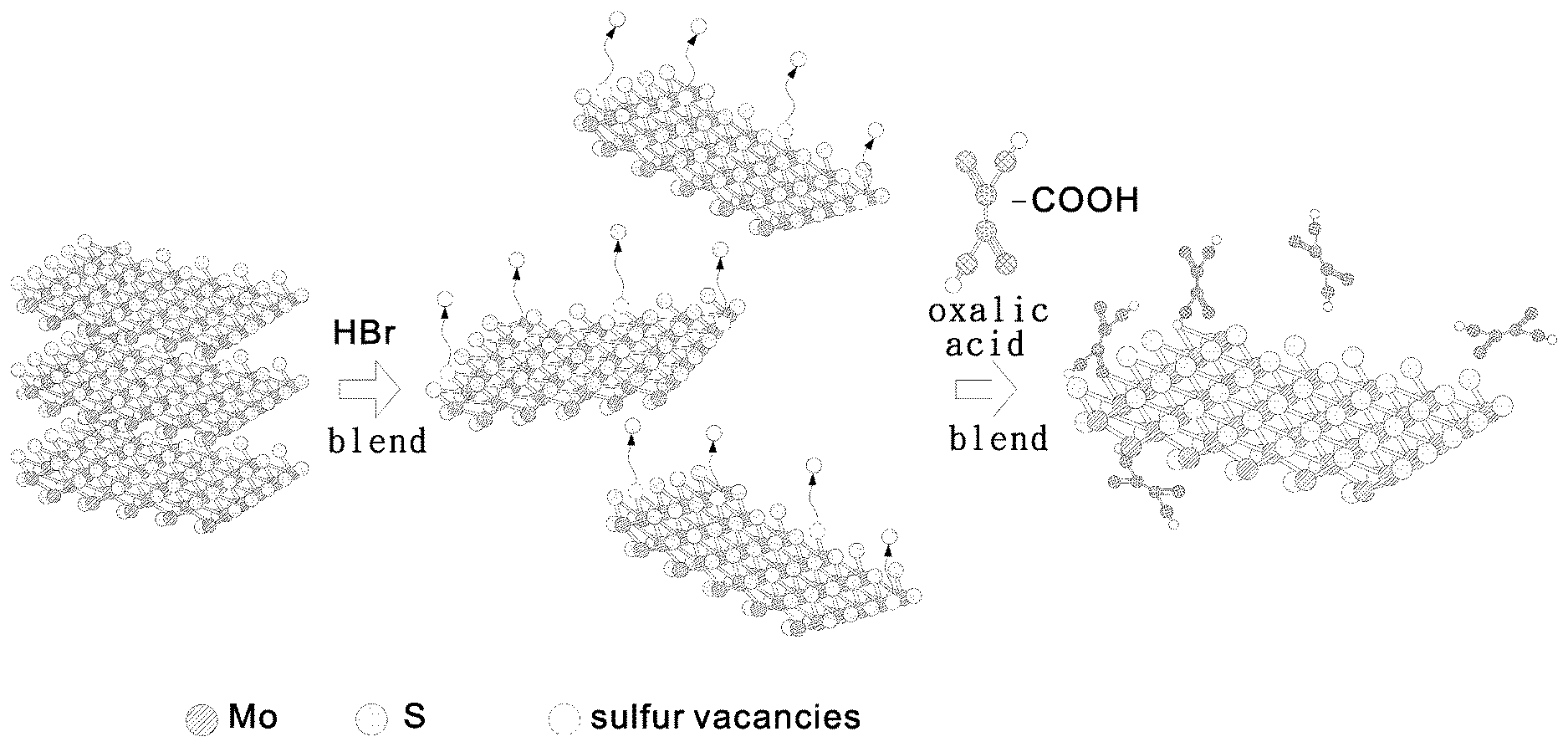

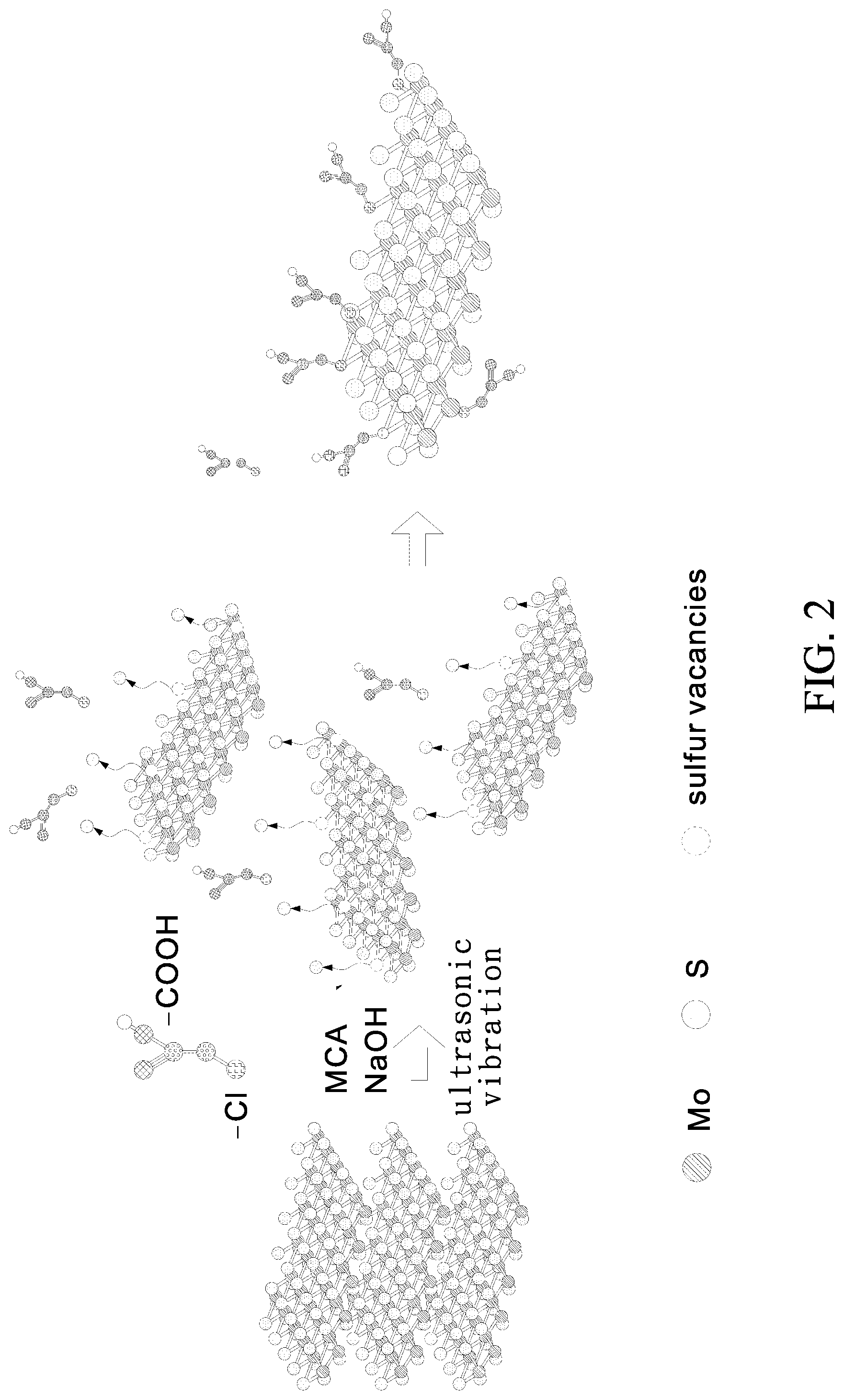
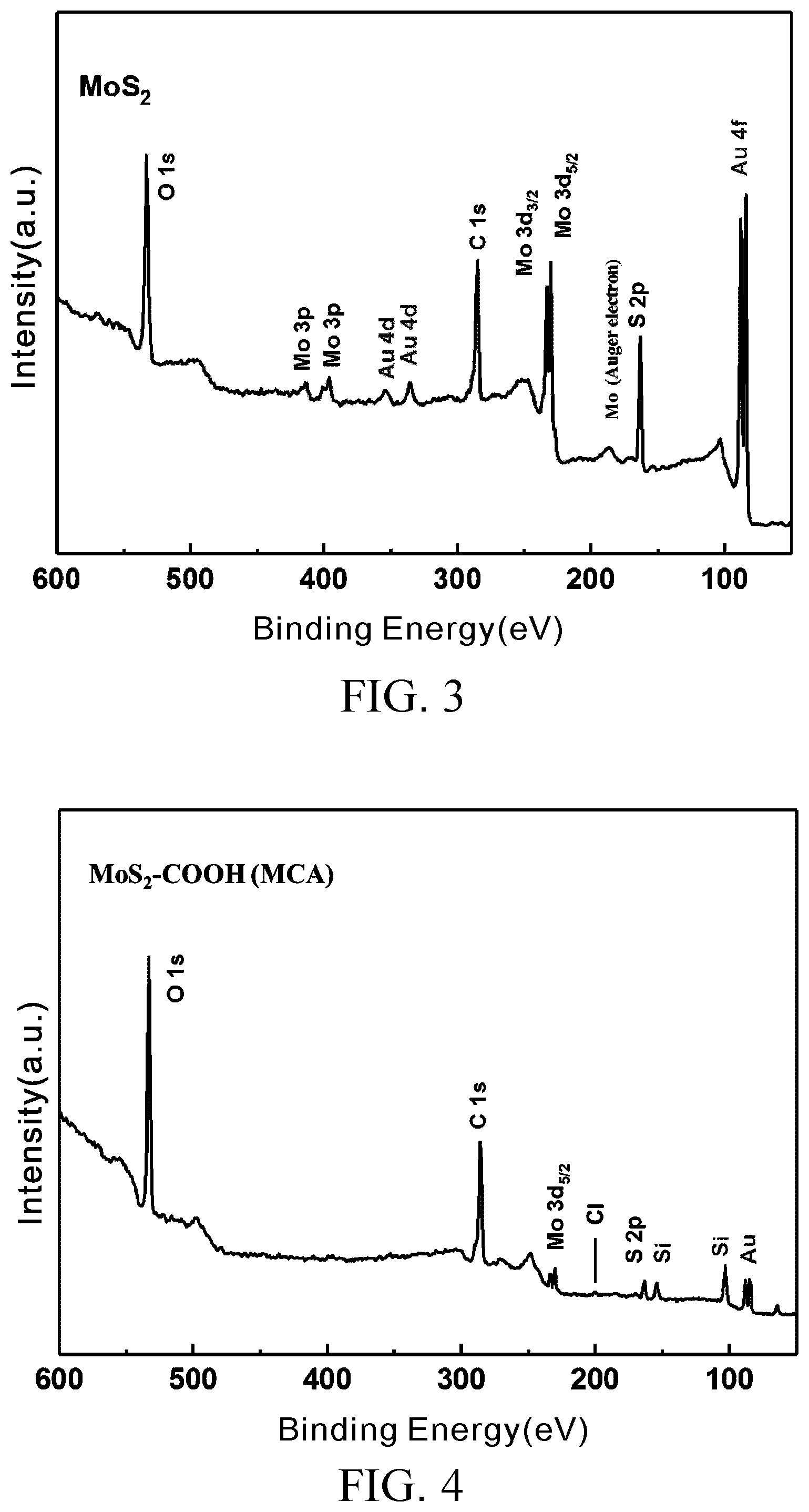
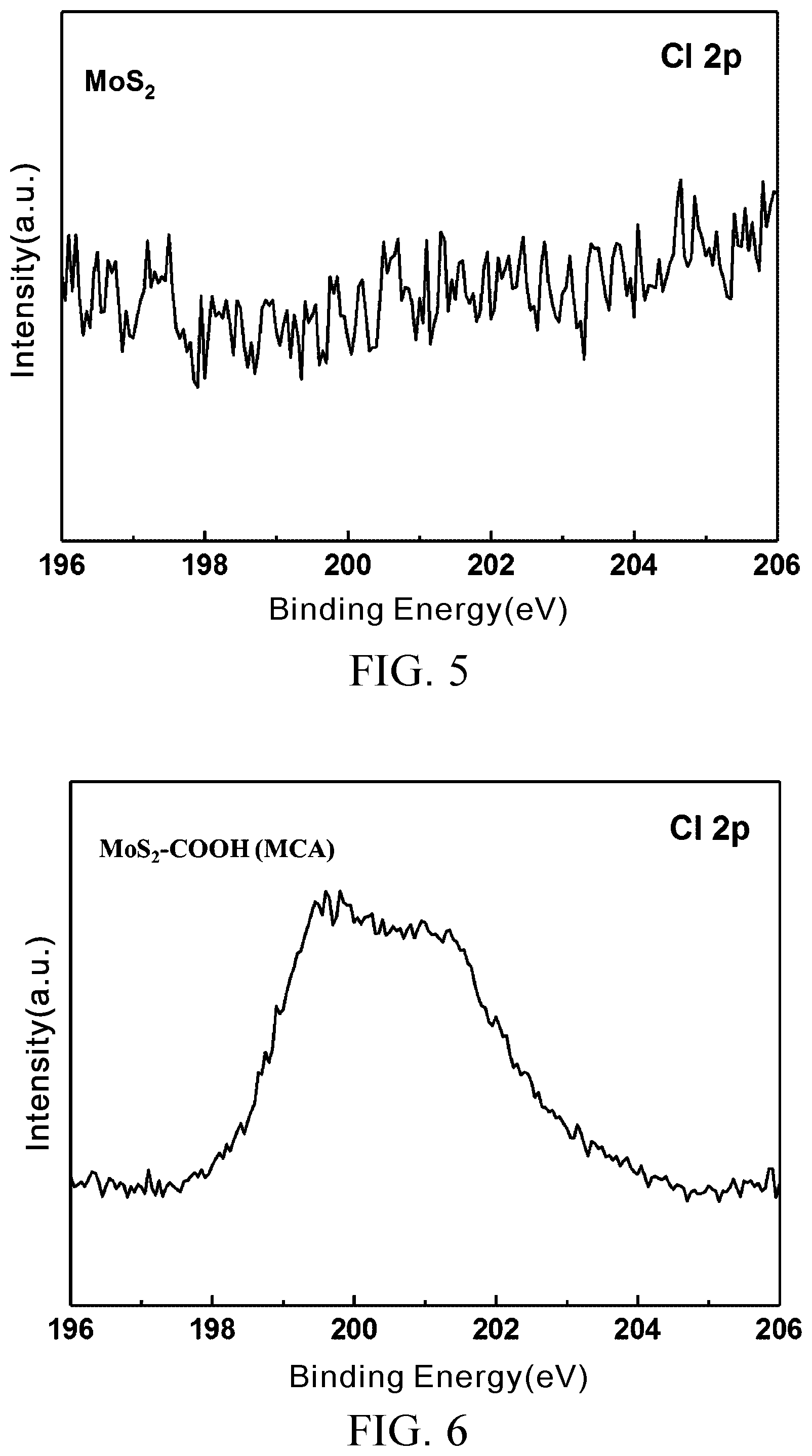
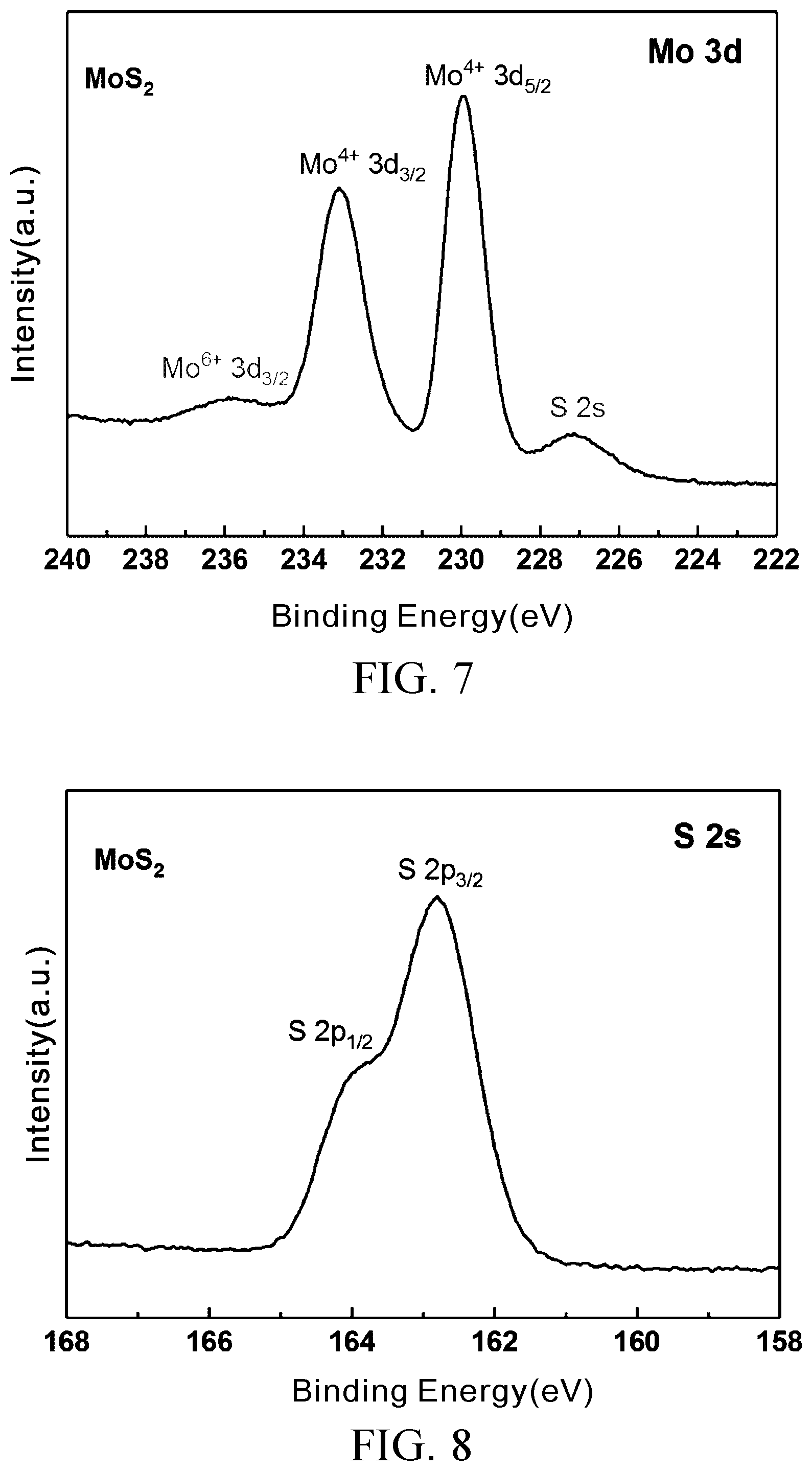
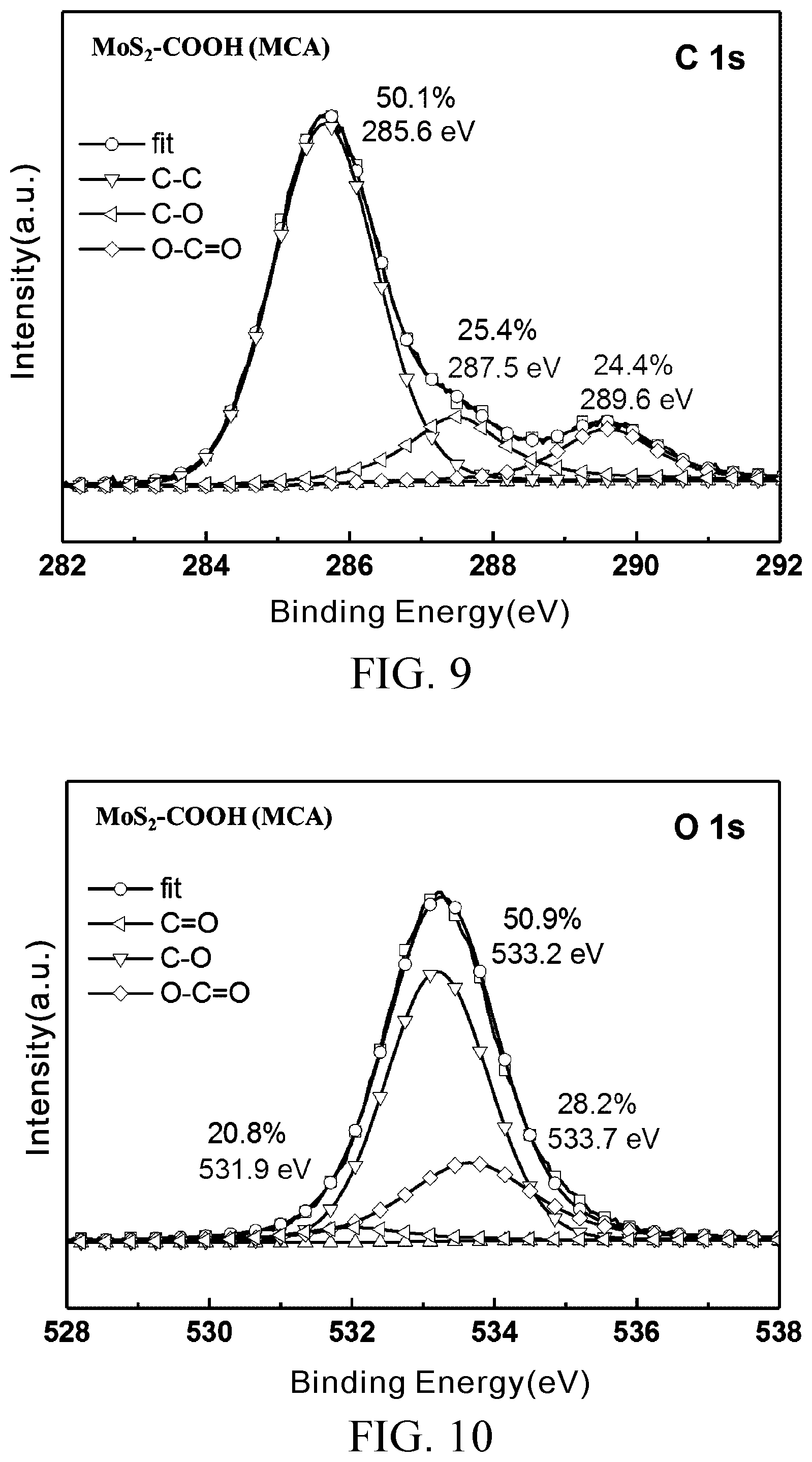
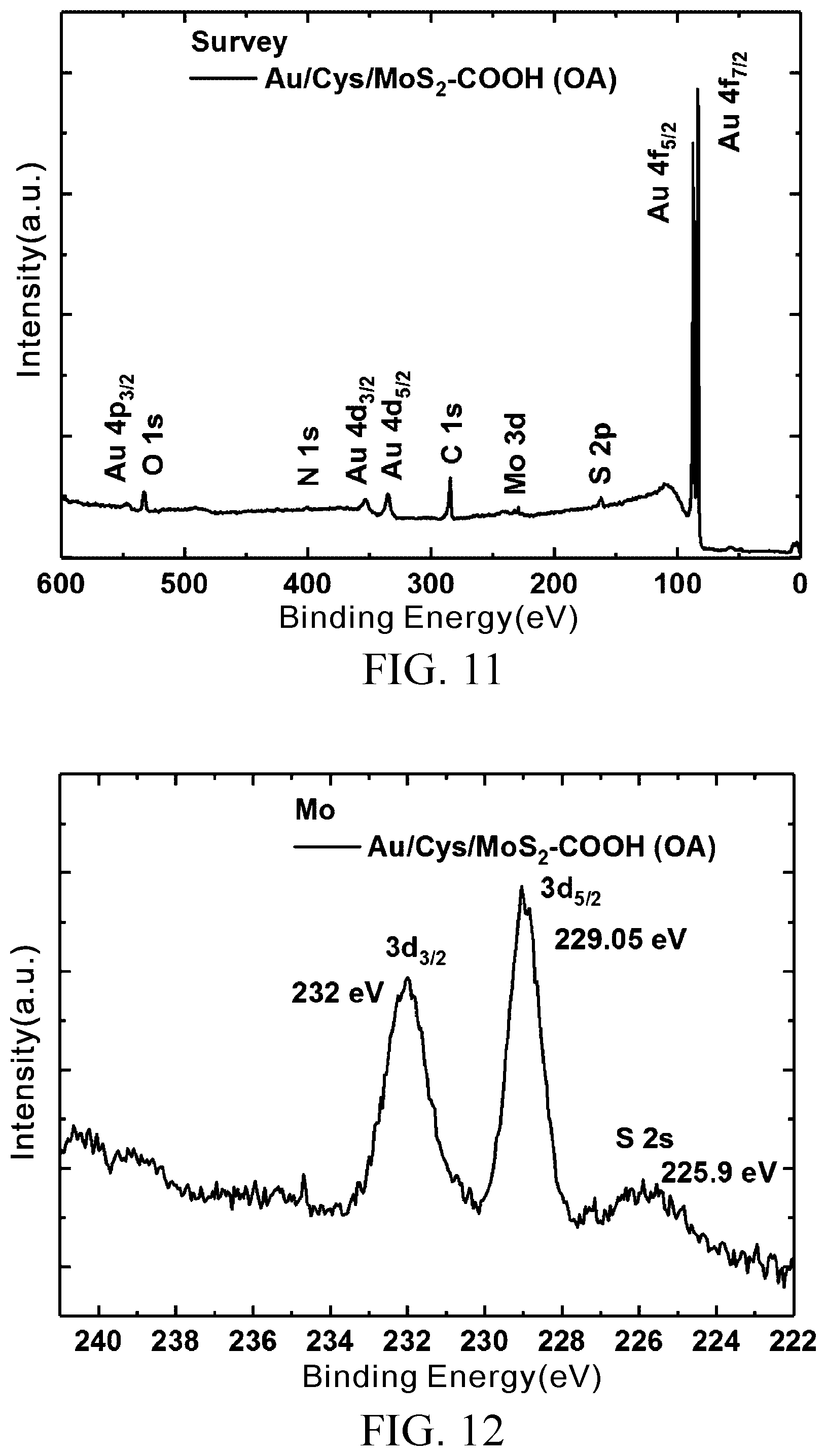
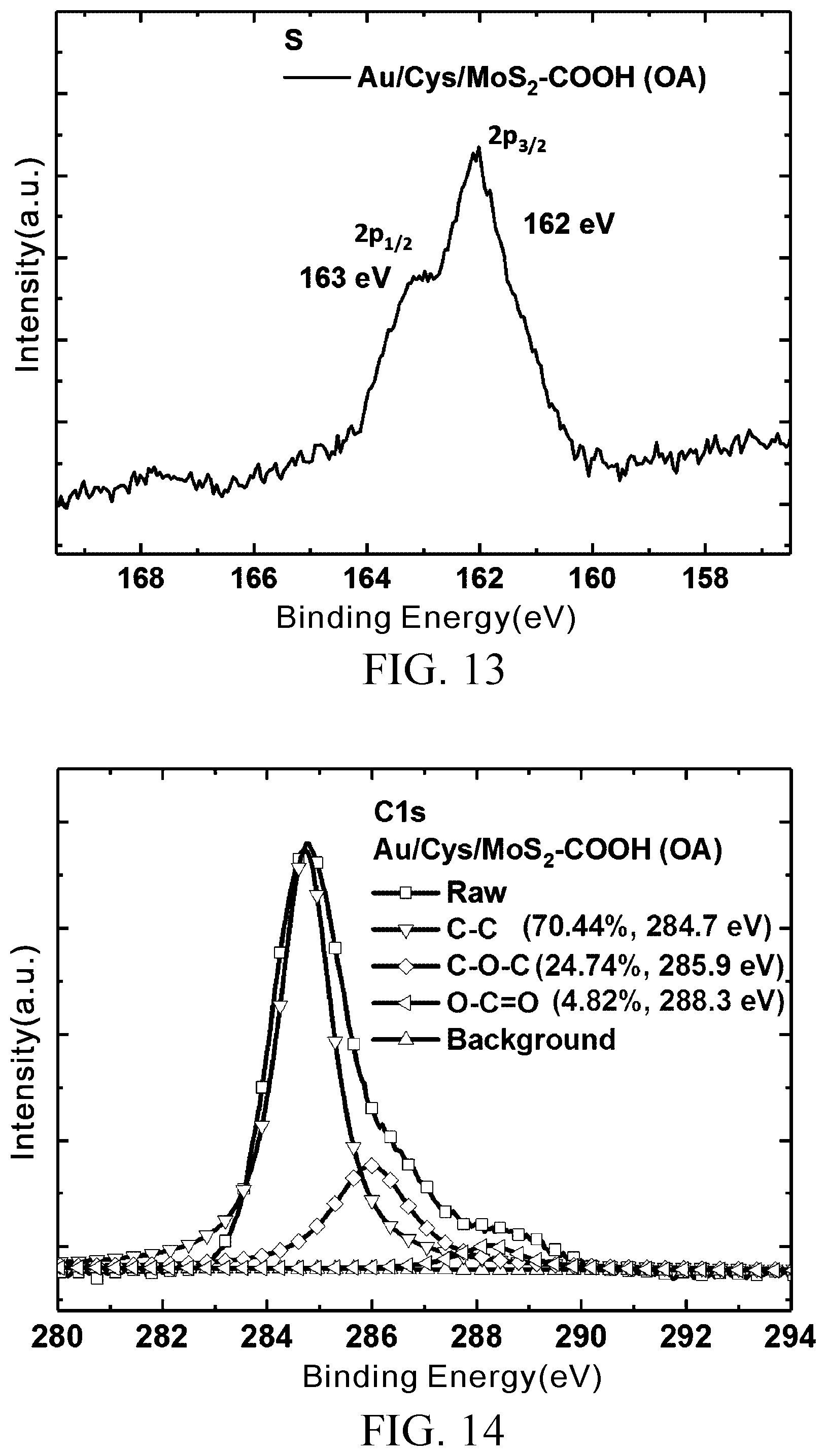
| United States Patent Application | 20190352319 |
| Kind Code | A1 |
| CHIU; NAN-FU ; et al. | November 21, 2019 |
METHOD OF SYNTHESIZING CARBOXYL-MODIFIED MOLYBDENUM DISULFIDE
Abstract
A method of synthesizing carboxyl-modified molybdenum disulfide comprises the steps of a) preparing a molybdenum disulfide solution; b) adding hydrogen bromide (HBr) to the molybdenum disulfide solution, followed by blending the mixture; and c) adding oxalic acid (OA) to the molybdenum disulfide solution, followed by blending the mixture. The molybdenum disulfide synthesized by the method is applicable to a biosensing chip. The carboxyl-modified molybdenum disulfide effectively enhances sensitivity of a detection device having the biosensing chip.
| Inventors: | CHIU; NAN-FU; (Taipei City, TW) ; LIN; TING-LI; (Taipei City, TW) | ||||||||||
| Applicant: |
|
||||||||||
|---|---|---|---|---|---|---|---|---|---|---|---|
| Assignee: | NATIONAL TAIWAN NORMAL
UNIVERSITY Taipei City TW |
||||||||||
| Family ID: | 65034497 | ||||||||||
| Appl. No.: | 15/963107 | ||||||||||
| Filed: | April 26, 2018 |
| Current U.S. Class: | 1/1 |
| Current CPC Class: | C08K 3/30 20130101; C01G 39/06 20130101; C01P 2002/85 20130101; C07F 11/005 20130101; C07F 11/00 20130101 |
| International Class: | C07F 11/00 20060101 C07F011/00 |
Foreign Application Data
| Date | Code | Application Number |
|---|---|---|
| Jan 15, 2018 | TW | 107101427 |
Claims
1. A method of synthesizing carboxyl-modified molybdenum disulfide, comprising the steps of: a) preparing a molybdenum disulfide solution; b) adding hydrogen bromide (HBr) to the molybdenum disulfide solution, followed by blending the mixture; and c) adding oxalic acid (OA) to the molybdenum disulfide solution, followed by blending the mixture.
2. The method of claim 1, wherein concentration of the molybdenum disulfide solution in step a) is 0.1.about.10 mg/ml.
3. The method of claim 1, wherein the blend in step b) takes 0.5.about.24 hours.
4. The method of claim 1, wherein the blend in step c) takes 0.5.about.24 hours.
5. A method of synthesizing carboxyl-modified molybdenum disulfide, comprising the steps of: a) preparing a molybdenum disulfide solution; and b) adding sodium hydroxide (NaOH) and monochloroacetic acid (MCA) to the molybdenum disulfide solution, followed by treating the mixture by ultrasonic vibration.
6. The method of claim 5, wherein concentration of the molybdenum disulfide solution in step a) is 0.1.about.10 mg/ml.
7. The method of claim 5, wherein the ultrasonic vibration in step b) takes 1-3 hours.
Description
CROSS-REFERENCE TO RELATED APPLICATION
[0001] This non-provisional application claims priority under 35 U.S.C. .sctn. 119(a) on Patent Application No(s).107101427 filed in Taiwan, R.O.C. on Jan. 15, 2018, the entire contents of which are hereby incorporated by reference.
FIELD OF THE INVENTION
[0002] The present invention relates to methods of synthesizing molybdenum disulfide and, more particularly, to a method of synthesizing carboxyl-modified molybdenum disulfide.
BACKGROUND OF THE INVENTION
[0003] Two-dimensional molybdenum disulfide (2D MoS.sub.2) is usually regarded as characterized by perfect lattices. In fact, sulfur vacancies are not only abundant on the surface of the molecule of molybdenum disulfide but also important to surface modification, as disclosed in R. Chianelli, M. Siadati, M. De la Rosa, G. Berhault, J. Wilcoxon, R. Bearden and B. Abrams, "Catalytic Properties of Single Layers of Transition Metal Sulfide Catalytic Materials," Catalysis Reviews, 2006, 48, 1-41.
[0004] Depending on its crystalline structure, molybdenum disulfide is of two types: 2H and 1T. Monolayer MoS.sub.2 of type 2H not only features a direct band gap but also demonstrates characteristics of semiconductor and photoluminescence. By contrast, type-1T MoS.sub.2 is metallic. Hence, it is worth noting that various synthesis methods are employed to change the nature of MoS.sub.2 by causing defects to the lattices of MoS.sub.2 or introducing excessive negative charges into the lattices of MoS.sub.2 so as to alter the 2H-1T ratio. Furthermore, surface modification provides more ways to modulate the characteristics of MoS.sub.2.
[0005] In 2010, A. Tuxen et al. (A. Tuxen, J. Kibsgaard, H. Gobel, E. L.ae butted.gsgaard, H. Topsoe, J. V. Lauritsen and F. Besenbacher, "Size Threshold in the Dibenzothiophene Adsorption on MoS.sub.2 Nanoclusters," ACS Nano, 2010, 4, 4677-4682) disclosed observing monolayer MoS.sub.2 nanoclusters which dibenzothiophene (DBT) is adsorbed to with a scanning tunneling microscope (STM), thereby giving the earliest direct proof of successful functionalization of transition metal dichalcogenide (TMD) materials. At present, well-known methods of functionalizing and modifying the surfaces of molecules of MoS.sub.2 involve causing defects, that is, S-vacancies, to the crystal lattices of MoS.sub.2 by chemical exfoliation and then introducing organic thiols to be adsorbed to the S-vacancies (D. Sim, M. Kim, S. Yim, M. Choi, J. Choi, S. Yoo and Y. S. Jung "Controlled Doping of Vacancy-Containing Few-Layer MoS.sub.2 via Highly Stable Thiol-Based Molecular Chemisorption," ACS Nano, 2015, 9, 12115-12123.) S. S. Chou et al. (S. Chou, M. De, J. Kim, S. Byun, C. Dykstra, J. Yu, J. Huang and V. P. Dravid, "Ligand Conjugation of Chemically Exfoliated MoS.sub.2," J. Am. Chem. Soc., 2013, 135, 4584-4587) disclosed mixing chemically exfoliated MoS.sub.2 and mercapto of polyethylene glycol (PEG) ligands roughly to form functionalized MoS.sub.2 molecule which carries a hydroxyl group, a carboxyl group, and trimethylammonium and thus serves as an aqueous 2D material which features significant colloidal stability. Last but not least, in 2016 A. R. McDonald et al. (X. Chen, N. C. Berner, C. Backes, G. S. Duesberg and A. R. McDonald, "Functionalization of Two-Dimensional MoS.sub.2: On the Reaction Between MoS.sub.2 and Organic Thiols," Angew. Chem. Int. Ed., 2016, 55, 5803-5808) disclosed that caution must be exercised in functionalizing TMD materials with organic thiols because the odds are that, instead of forming bonds with the surfaces of the molecules of MoS.sub.2, thiols will be physically adsorbed thereto and thus easily removed therefrom.
[0006] Although the development of technology of functionalization of MoS.sub.2 is still in its early stage, it will be rapid when following that of covalent modification of the other nanomaterials. Furthermore, functionalized MoS.sub.2 has a lot of potential in terms of its application to biomedicine, because of its high photothermal performance, high photoluminescence, high sensitivity to environmental factors, and excellent biocompatibility.
SUMMARY OF THE INVENTION
[0007] Conventional methods of functionalizing MoS.sub.2 still have room for improvement. In view of this, it is an objective of the present invention to provide a method of synthesizing carboxyl-modified molybdenum disulfide such that the surface of the molecule of molybdenum disulfide is effectively modified with a carboxyl group (--COOH).
[0008] In order to achieve the above and other objectives, the present invention provides a method of synthesizing carboxyl-modified molybdenum disulfide, comprising the steps of: [0009] a) preparing a molybdenum disulfide solution; [0010] b) adding hydrogen bromide (HBr) to the molybdenum disulfide solution and blending the mixture; and [0011] c) adding oxalic acid (OA) to the molybdenum disulfide solution and blending the mixture.
[0012] In an embodiment of the present invention, the molybdenum disulfide solution in step a) is of a concentration of 0.1.about.10 mg/ml.
[0013] In an embodiment of the present invention, the blend in step b) takes 0.5.about.24 hours.
[0014] In an embodiment of the present invention, the blend in step c) takes 0.5.about.24 hours.
[0015] In order to achieve the above and other objectives, the present invention further provides a method of synthesizing carboxyl-modified molybdenum disulfide, comprising the steps of: [0016] a) preparing a molybdenum disulfide solution; and [0017] b) adding sodium hydroxide (NaOH) and monochloroacetic acid (MCA) to the molybdenum disulfide solution and allowing the mixture to undergo ultrasonic vibration.
[0018] In an embodiment of the present invention, the molybdenum disulfide solution in step a) is of a concentration of 0.1.about.10 mg/ml.
[0019] In an embodiment of the present invention, the ultrasonic vibration in step b) takes 1-3 hours.
[0020] Unlike conventional methods of functionalizing MoS.sub.2, the method of synthesizing carboxyl-modified molybdenum disulfide according to the present invention effectively modifies the surface of the molecule of molybdenum disulfide with a carboxyl group (--COOH). The molybdenum disulfide synthesized by the method of the present invention is applicable to a biosensing chip. With the molybdenum disulfide being carboxyl-modified, the sensitivity of a detection device comprising the biosensing chip is enhanced effectively.
BRIEF DESCRIPTION OF THE DRAWINGS
[0021] Objectives, features, and advantages of the present invention are hereunder illustrated with specific embodiments in conjunction with the accompanying drawings, in which:
[0022] FIG. 1 is a schematic view of a synthesis method according to Embodiment 1 of the present invention;
[0023] FIG. 2 is a schematic view of a synthesis method according to Embodiment 2 of the present invention;
[0024] FIG. 3 is an XPS full spectrum of MoS.sub.2;
[0025] FIG. 4 is an XPS full spectrum of MoS.sub.2--COOH (MCA) prepared in Embodiment 2;
[0026] FIG. 5 is an XPS fine scan of element chlorine of MoS.sub.2;
[0027] FIG. 6 is an XPS fine scan of element chlorine of the MoS.sub.2--COOH (MCA) prepared in Embodiment 2;
[0028] FIG. 7 is an XPS fine scan of element molybdenum of MoS.sub.2;
[0029] FIG. 8 is an XPS fine scan of element sulfur of MoS.sub.2;
[0030] FIG. 9 shows the result of analysis of group content of element carbon of the MoS.sub.2--COOH (MCA) prepared in Embodiment 2;
[0031] FIG. 10 shows the result of analysis of group content of element oxygen of the MoS.sub.2--COOH (MCA) prepared in Embodiment 2;
[0032] FIG. 11 is an XPS full spectrum of MoS.sub.2--COOH (OA) prepared in Embodiment 1;
[0033] FIG. 12 is an XPS fine scan of element molybdenum of the MoS.sub.2--COOH (OA) prepared in Embodiment 1;
[0034] FIG. 13 is an XPS fine scan of element sulfur of the MoS.sub.2--COOH (OA) prepared in Embodiment 1; and
[0035] FIG. 14 shows the result of analysis of group content of element chlorine of the MoS.sub.2--COOH (OA) prepared in Embodiment 1.
DETAILED DESCRIPTION OF THE PREFERRED EMBODIMENTS
[0036] The sizes of atoms and molecules shown in the drawings of the present invention are adjusted, omitted or simplified for the sake of illustration and clarity. Regarding related components, the drawings of the present invention are not drawn to scale.
Embodiment 1: Modifying Molybdenum Disulfide with Oxalic Acid (OA)
[0037] FIG. 1 is a schematic view of a synthesis method according to Embodiment 1 of the present invention. Referring to FIG. 1, the synthesis method in Embodiment 1 of the present invention is described below.
[0038] Steps of Synthesis:
[0039] a) preparing 15 ml of 2 mg/ml molybdenum disulfide solution with deionized water;
[0040] b) adding 5 mL of hydrogen bromide (HBr) to the molybdenum disulfide solution prepared in step a) and blending the mixture for 12 hours; and
[0041] c) adding 1.5 g of oxalic acid (OA) to the mixture prepared in step b) and blending the resultant mixture with a rocker for 4 hours (speed 4) to form OA-modified molybdenum disulfide.
[0042] It is feasible to perform centrifugal separation on the evenly mixed solution formed in step c) above with a centrifugal separator and then replace the supernatant with deionized water, thereby producing a carboxyl-modified molybdenum disulfide aqueous solution (MoS.sub.2--COOH (OA)).
[0043] In step a), the concentration of the molybdenum disulfide solution is not restricted by the present invention. Preferably, the concentration of the molybdenum disulfide solution is 0.1.about.10 mg/ml.
[0044] In step b), the duration of the blend is not restricted by the present invention.
[0045] Preferably, the blend takes 0.5.about.24 hours.
Embodiment 2: Modifying Molybdenum Disulfide with Monochloroacetic Acid (MCA)
[0046] FIG. 2 is a schematic view of a synthesis method according to Embodiment 2 of the present invention. Referring to FIG. 2, the synthesis method in Embodiment 2 of the present invention is described below.
[0047] Steps of Synthesis: [0048] a) preparing 15 ml of 2 mg/ml molybdenum disulfide solution with deionized water; and [0049] b) adding 1.2 g of sodium hydroxide (NaOH) and 1.0 g of monochloroacetic acid (MCA) to the molybdenum disulfide solution and allowing the mixture to undergo ultrasonic vibration for 1-3 hours, so as for sulfur vacancies to form on the surface of MoS.sub.2 and for the sulfur vacancies to be occupied by chlorine atoms of the monochloroacetic acid, thereby forming MCA-modified molybdenum disulfide.
[0050] Afterward, the evenly mixed solution formed in step b) above undergoes centrifugal separation with a centrifugal separator, and then the supernatant is replaced with deionized water, thereby producing a MCA-modified carboxyl-containing molybdenum disulfide aqueous solution, also known as MoS.sub.2--COOH (MCA).
[0051] Test Example 1 and Test Example 2, which are described below, involve not only analyzing MoS.sub.2--COOH (OA) prepared in Embodiment 1 and MoS.sub.2--COOH (MCA) prepared in Embodiment 2 with X-ray photoelectron spectroscopy (XPS), but also analyzing MoS.sub.2 with XPS to serve as a control.
[0052] FIG. 3 and FIG. 4 are XPS full spectra of MoS.sub.2 and MoS.sub.2--COOH (MCA) prepared in Embodiment 2, respectively. FIG. 5 and FIG. 6 are XPS fine scans of element chlorine of MoS.sub.2 and element chlorine of the MoS.sub.2--COOH (MCA) prepared in Embodiment 2, respectively.
Test Example 1: XPS-Based Analysis of MoS.sub.2--COOH (MCA) Prepared in Embodiment 2
[0053] X-ray photoelectron spectroscopy (XPS), also known as electron spectroscopy for chemical analysis (ESCA), is a surface-sensitive quantitative spectroscopic technique that not only measures the elemental composition of a material but is also capable of analyzing chemical bonds. Surface modification is the act of modifying or improving the surface of a material in terms of its characteristics and thus is applicable to the analysis of the chemical characteristics of the surface of a material and surface engineering research. In Test Example 1, XPS is performed with the 24A1 beam of Taiwan's National Synchrotron Radiation Research Center (NSRRC) with a view to detecting whether the surface of a material is modified with a carboxyl group (--COOH) and analyzing the types and contents of oxygen-containing groups of element carbon and element oxygen after the surface modification.
[0054] The course of XPS is accompanied by abundance of easily-measured carbon and oxygen atoms, which is true even when unmodified MoS.sub.2 is being measured. Test Example 1 aims to calculate the carbon to molybdenum ratio of intensity and the oxygen to molybdenum ratio of intensity, so as to confirm whether the carbon and oxygen content of the material has increased and confirm whether the modification is successful.
[0055] Referring to FIG. 3 and FIG. 4, main characteristic peak values of Au fall at 84 eV (Au 4f.sub.7/2) and 88 eV(Au 4f.sub.5/2), and the former is used as a reference for correction of the measurement results of Test Example 1. As indicated by a comparison of FIG. 3 and FIG. 4, in addition to the difference in intensity ratio between the elements, a peak value, which is not shown in FIG. 3, is shown in FIG. 4 at 200 eV and identified by table lookup to be a characteristic peak of Cl 2p.
[0056] In Embodiment 2, the mechanism for MCA-based modification of MoS.sub.2 involves occupation of sulfur vacancies by chlorine atoms. A fine scan of MoS.sub.2 and a fine scan of MoS.sub.2--COOH (MCA) prepared in Embodiment 2 are performed at 196 eV through 206 eV to confirm whether the modified MoS.sub.2--COOH (MCA) contains element chlorine, only to reveal that they contain little element chlorine as shown in FIG. 5 and FIG. 6. However, FIG. 6 proves a fact about the MoS.sub.2--COOH (MCA) prepared in Embodiment 2, that is, the surface of the molecule of MoS.sub.2 is modified with MCA through the occupation of sulfur vacancies by chlorine atoms.
[0057] Analysis of Group Content:
[0058] Test Example 1 entails performing fine analysis of the group content of the MoS.sub.2--COOH (MCA) prepared in Embodiment 2 with X-ray photoelectron spectroscopy (XPS) and that of MoS.sub.2, and using the analysis result of the latter as a control.
[0059] FIG. 7 and FIG. 8 are XPS fine scans of element molybdenum and element sulfur of MoS.sub.2, respectively. FIG. 9 and FIG. 10 show the results of analysis of group content of element carbon and element oxygen of the MoS.sub.2--COOH (MCA) prepared in Embodiment 2, respectively.
[0060] FIG. 7 shows two characteristic peaks of Mo of MoS.sub.2, namely Mo.sup.4+3d.sub.5/2 (230 eV) and Mo.sup.4+3d.sub.3/2 (233 eV), and a S 2s peak value at 227 eV. FIG. 8 shows two characteristic peaks of S of MoS.sub.2, namely S 2p.sub.3/2 (162.8 eV) and S 2p.sub.1/2 (163.95 eV). When compared with MoS.sub.2, the S peak value and Mo of the MoS.sub.2--COOH (MCA) prepared in Embodiment 2 demonstrate no significant change. FIG. 9 and FIG. 10 show the results of analysis of fine scans of characteristic peaks of element carbon and element oxygen of the MoS.sub.2--COOH (MCA) prepared in Embodiment 2 to identify the types of bonds between a carbon atom, an oxygen atom, and any other element. As shown in FIG. 9, C1s has two characteristic peaks each including three different sub-peaks, namely C--C, C--O and O--C.dbd.O, and located at 258.6 eV, 287.5 eV and 289.6 eV, respectively (X. Yang, N. Meng, Y. Zhu, Y. Zhou, W. Nie and P. Chen, "Greatly Improved Mechanical and Thermal Properties of Chitosan by Carboxyl-Functionalized MoS.sub.2 Nanosheets," J. Mater. Sci., 2015, 51, 1344-1353), wherein O--C.dbd.O corresponds to a carboxyl group obviously and has a high proportion of 24.4%. The analysis results show that C1s accounts for the majority of the oxygen-containing groups of the MoS.sub.2--COOH (MCA). With reference to M. Beluomini, J. da Silva, G. Sedenho and N. Stradiotto, "D-mannitol Sensor Based on Molecularly Imprinted Polymer on Electrode Modified with Reduced Graphene Oxide Decorated with Gold Nanoparticles," Talanta, 2017, 165, 231-239, Test Example 1 entails analyzing O1s characteristic peaks and reveals that O1s includes three different sub-peaks, namely C.dbd.O, C--O and O--C.dbd.O, which are located at 531.9 eV, 533.2 eV, and 533.7 eV, respectively, with O--C.dbd.O accounting for 28.2% of the groups, as shown in FIG. 10.
Test Example 2: XPS-Based Analysis of MoS.sub.2--COOH (OA) Prepared in Embodiment 1
[0061] FIG. 11 is an XPS full spectrum of MoS.sub.2--COOH (OA) prepared in Embodiment 1. FIG. 12 is an XPS fine scan of element molybdenum of the MoS.sub.2--COOH (OA) prepared in Embodiment 1, showing two characteristic peaks, namely Mo.sup.4+3d.sub.5/2(229.05 eV) and Mo.sup.4+3d.sub.3/2 (232 eV), and an S 2s peak value at 225.9 eV. FIG. 13 is an XPS fine scan of element sulfur of the MoS.sub.2--COOH (OA) prepared in Embodiment 1, showing two characteristic peaks, namely S 2p.sub.3/2 (162 eV) and S 2p.sub.1/2 (163 eV), wherein the Mo, S peak values of MoS.sub.2--COOH (OA) demonstrate no significant change.
[0062] Afterward, a fine scan of C1s characteristic peaks of MoS.sub.2--COOH (OA) is carried out, revealing the types of bonds of carbon atom and the other elements. FIG. 14 shows the result of analysis of group content of element chlorine of the MoS.sub.2--COOH (OA) prepared in Embodiment 1. As shown in FIG. 14, C1s has two characteristic peaks each including three different sub-peaks, namely C--C, C--O--C and O--C.dbd.O, and located at 284.7 eV, 285.9 eV and 288.9 eV, respectively (X. Yang, N. Meng, Y. Zhu, Y. Zhou, W. Nie and P. Chen, "Greatly Improved Mechanical and Thermal Properties of Chitosan by Carboxyl-Functionalized MoS.sub.2 Nanosheets," J. Mater. Sci., 2015, 51, 1344-1353), wherein O--C.dbd.O corresponds to a carboxyl group obviously and has a high proportion of 4.82%. The analysis results show that C1s accounts for the majority of the oxygen-containing groups of the MoS.sub.2--COOH (OA).
[0063] The XPS-based analyses described in Test Example 1 and Test Example 2 prove that a method of synthesizing carboxyl-modified molybdenum disulfide according to the present invention can modify the surface of the molecule of molybdenum disulfide with a carboxyl group (--COOH). The result of the analysis of the group content in Test Example 2 proves that the method of synthesizing carboxyl-modified molybdenum disulfide according to the present invention can modify the surface of the molecule of molybdenum disulfide with a carboxyl group (--COOH) to a large extent.
[0064] The molybdenum disulfide synthesized by the method of the present invention is applicable to a biosensing chip. The carboxyl-modified molybdenum disulfide effectively enhances sensitivity of a detection device having the biosensing chip.
[0065] The present invention is disclosed above by preferred embodiments. However, persons skilled in the art should understand that the preferred embodiments are illustrative of the present invention only, but shall not be interpreted as restrictive of the scope of the present invention. Hence, all equivalent modifications and replacements made to the aforesaid embodiments shall fall within the scope of the present invention. Accordingly, the legal protection for the present invention shall be defined by the appended claims.
* * * * *
D00000

D00001

D00002

D00003

D00004

D00005

D00006

D00007

D00008

XML
uspto.report is an independent third-party trademark research tool that is not affiliated, endorsed, or sponsored by the United States Patent and Trademark Office (USPTO) or any other governmental organization. The information provided by uspto.report is based on publicly available data at the time of writing and is intended for informational purposes only.
While we strive to provide accurate and up-to-date information, we do not guarantee the accuracy, completeness, reliability, or suitability of the information displayed on this site. The use of this site is at your own risk. Any reliance you place on such information is therefore strictly at your own risk.
All official trademark data, including owner information, should be verified by visiting the official USPTO website at www.uspto.gov. This site is not intended to replace professional legal advice and should not be used as a substitute for consulting with a legal professional who is knowledgeable about trademark law.